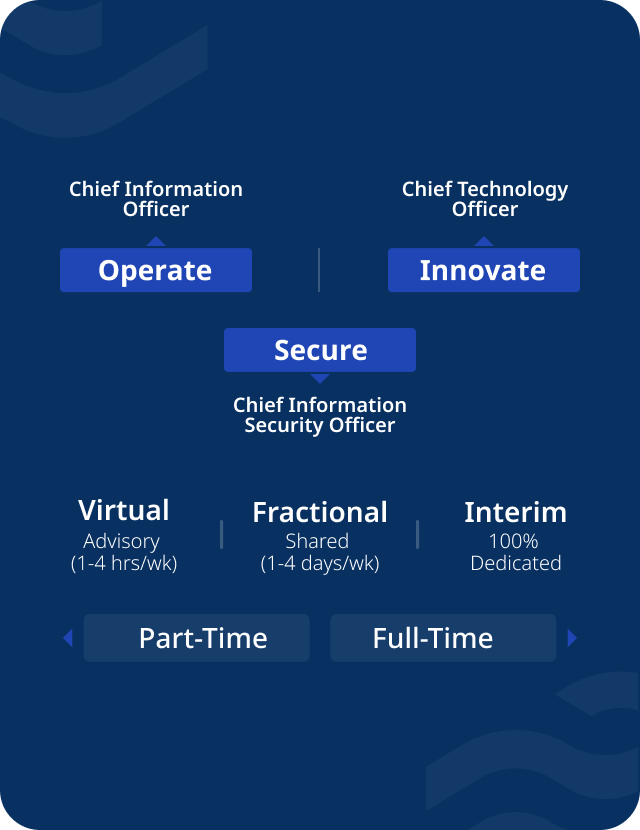- WHAT WE DO /
- CIO SERVICES
Hire a CIO to Help
Grow Your Business
From the #1 Provider of
Technology Leadership
Our CIOs offer specialized technology leadership on a flexible schedule, optimizing your technology spend for maximum business impact.


Challenges CEOs face in Managing Technology:
- Lack of time and expertise.
- The need to stay ahead of the latest trends and technologies.
- Inability to attract or afford the right talent.
- Risk of hiring the "wrong" person- full-time.
- How best to align technologies with business goals.

A CIO can help CEOs overcome these challenges by:
- Providing expert technology leadership and guidance on a part-time basis.
- Helping CEOs develop and implement a strategic technology plan.
- Overseeing the day-to-day management of technology operations.
- Managing technology projects and ensuring that they are completed on time and within budget
- Aligning the above to make an impact on business.
Technology Leadership as-a-Service™
Virtual, Fractional, or Interim Technology Leadership

We help you find the right CIO.
For the right amount of time.
Fortium offers a valuable alternative to the conventional hiring process with TLaaS™. Leverage the expertise of proven CIOs ready to deliver from day one and eliminate the uncertainties and long-term commitments associated with permanent hires. We help CEOs find the right fractional CIO to fit their needs.
How will a CIO Support your Business Objectives?
Understand
The organization's basic needs and aspirational desires
Maintain
The organization's desired state by continuously iterating: assess, align, remediate, and operate
Lead
Influence, communicate to, collaborate with, and provide executive presence to stakeholders
Develop
A recommended level of technology spend
Your role in serving as our interim CIO and assisting with the planning and budgeting was incredible. Your extensive evaluation of our procedures and needs was extremely thorough which led to such great results. Thank you for turning on the light so we can see our path more clearly.

Financial Services Client
CEO
Frequently Asked Questions
Have questions? We're here to help
The Chief Information Officer (CIO) is an organization's most senior technology executive who reports to a non-technology executive. A CIO usually reports to the CEO but may also report to the CFO, COO, or another executive. The CIO is responsible for creating and implementing a technology strategy, executing it with people and investment, and aligning it with the CEO's and organization's vision and goals. The CIO is a strategic advisor, a thought leader, and a trusted confidante who is ultimately responsible for the entire organization's technology.
All but the very smallest of companies can benefit from the advice and insight of a CIO. The driver for that need can vary considerably, though, between organizations. Those needs can increase and decrease in importance over time and in response to internal initiatives and external pressures.
There is a natural rhythm within the technology function of periods of innovation and increasing capabilities balanced with periods of stability and exploiting prior change. This technology innovation/stability cycle often influences the type of CIO needed and can play a role in the motivation of a CIO to stay, leave, or be attracted to an organization in search of a point within that rhythm that is more attractive to them.
All but the very smallest of organizations can benefit from the advice and insight of a CIO. What varies most is how much of a CIO's time is needed to impact the organization and whether it has adopted a technology leadership model that can scale from a few hours per week to full-time without sacrificing leadership experience.
Chief Technology Officer
The most common title used interchangeably with CIO is the Chief Technology Officer or CTO. With a primary focus on technology, many assume the titles are synonymous. What they do have in common is that CIO and CTO both refer to the most senior technology-specific leader in an organization. The CTO, however, is mainly used for the senior technology role in an organization that derives most of its revenue from creating technology (a technology maker) and selling it to its customers: mostly commonly software companies. Since the CIO is often the senior technology leader in an organization that derives most of its revenue from something other than selling technology, the CIO tends to be primarily a buyer (a technology buyer) of the CTO's products for use within their organizations. Such a definition might not be universally shared but bringing clarity to a topic poorly understood outside of the technology domain is a helpful contribution.
Director of Information Technology
The Director of Information Technology, or the Information Technology Director (IT Director), is another title commonly used to describe an organization's more senior technology-specific leader. The IT Director is substantially similar to the CIO role and usually serves an organization that is primarily a technology buyer rather than a technology maker. The difference is that the IT Director usually leads technology in a smaller organization, typically has less business and leadership experience than a CIO, and reports to someone other than the CEO (often the CFO). The result is that the IT Director has a more operational and tactical focus than a strategic focus. The IT Director typically aspires to the CIO role as they gain more business and leadership experience.
Chief Digital Officer
The Chief Digital Officer, or CDO, is a relatively new title used for technology leadership. Its use is part of a trend that includes additional, similar titles, including:
- Chief Data Officer (also CDO)
- Chief Innovation Officer (another CIO)
- Chief Digital and Technology Officer (CDTO)
- Chief Information Technology Officer (CITO)
- Chief Information and Digital Officer (CIDO) or the
- Chief Technology and Operating Officer (CTOO)
Most fractional and interim CIO providers will be able to get started very quickly, often providing viable candidates within hours to days and beginning within one to two weeks if speed is essential.
1. An initial discussion with a leader having extensive experience helping organizations evaluate and select fractional and interim CIOs will uncover specific requirements and prompt deeper dialog about the factors that will produce the best fit among available resources.
2. Based on the organization's preferences and the number of resources fitting the request, the provider presents one to three technology leaders with associated biographies and experience. Some situations may prompt a proposal covering the understanding of the situation, the approach to solving the need, and a discussion of the proposed people.
3. If a proposed CIO is acceptable, an agreement between the organizations is signed. The new CIO may start as soon as the CIO and client can arrange a mutually agreeable date.The biggest challenge hiring a CIO solves is finding someone to take responsibility and accountability for all technology decisions within an organization. More than a simplistic observation, this transfer of responsibility for technology to a highly competent CIO is one of the most liberating and impactful decisions a CEO will make. From that point forward, the CIO sets out to understand the goals and challenges of the organization, the impact and success of past investments in technology products, services, and people, and how to best leverage technology to enable even greater organizational success.
Have more questions?
Download our e-book, "The CEOs Guide to Hiring a CIO"
Four Reasons Your Business Needs a Virtual, Fractional, or Interim CIO
Rapid Growth
As an organization experiences rapid growth, reliance on manual procedures, entry-level IT support, and makeshift solutions from non-tech leaders become inadequate. This signals the immediate need for an experienced CIO.
Fill a Vacancy
The existing CIO has left through voluntary or involuntary separation, and the organization needs to fill the role quickly. An interim CIO can also help the CEO find a new CIO
Temporary Leave
The existing CIO is on temporary leave, and the organization needs to maintain momentum and provide leadership to the technology organization in its absence.
Not Enough Experience
Existing technology leadership, whether holding the CIO title or not, is too junior or overly technical in their focus. Or internal/external changes can expose gaps in an existing CIO's capabilities
Fortium also provides

Chief Technology Officer (CTO)
Senior technology leader responsible for commercial software product development, reporting to the CEO or similar; usually in a technology organization

Chief Information Security Officer (CISO)
Senior technology leader responsible for the overall security and compliance posture of an organization, generally, though not always, reporting to the CIO/CTO with CEO and Board autonomy, for technology and non-technology organizations
Level up your technology strategy today - sign up for a free consultation.
- Save time and money
- Get access to expert IT leadership and guidance
- Focus on core business priorities
- Improve IT performance and reliability
Are you a Technology Leader looking to join Fortium as a Partner? Click here
